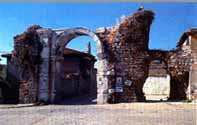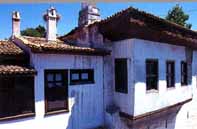|
Yatağından çıkarılan
mermerlerle çevresindeki antik kentleri güzelleştiren Sodra Dağının
eteklerine kurulmuş Milas.
Antik Çağda, Milasın da
bulunduğu Büyük Menderes ile Dalaman Çayı arasında kalan bölge
Kanalı'ların yönetimindeydi. Pers, Makedonya ve Slevkos
egemenlikleninin ardından Romaya bağlandı. Bizans döneminde
piskoposluk merkezi olan Milas, 13. yüzyılın sonunda Menteşe
Beyliğine başkentlik yaptı. Şimdi de mağrur oluşu bundan
olmalı.
Tapınaklar şehri Mylasa...
Çeşitli sıfatlarla anılan Karialıların baştanrısı Zeusa
adanmış pek çok tapınak bulunurmuş Mylasada. Bu yüzden
zamanın hac yeriymiş. George Bean Kana adlı kitabında nükteleri
ile ünlü arpçı Stratonikosun kentte verdiği resitale başlarken
tapınaklanın çokluğundan etkilenerek, alışılagelmiş
insanlara kulak ver sözünü bir kenara bırakıp tapınaklara
kulak ver dediğini aktarıyor. Bugün, ne yazık ki, seslenini
duyuramıyorlar artık.
 |
Biz, Milasa ulaşmak için
Bodrumdan yola çıktık. Bafa Gölünü geçtikten sonra
etrafımız zeytin ağaçlarıyla sarıldı. Dağ taş alabildiğine
zeytin ağacı. Ne de olsa dünyada kişi başına düşen zeytin ağacı
yönünden ilk sırayı alan bölgedeyiz. Milasın girişinde
bizi önce leylekler karşılıyor. Daha sonra kenti gezerken, kimi
zaman bir tapınak kalıntısının tepesinde, ya da eski bir Milas
evinin bacasında sık sık rastlayacağımız bir manzara bu.
Binden, birbirinden renkli üç ev gözümüze çarpıyor.
Masallardaki pasta evler gibi canlı renklenle sıvalı, pencere,
balkon ve kapı demirleni beyaz boyalı bu evler çok iyi durumda.
Önce, işte karşımızda ünlü Milas evleri diye düşünüyoruz.
Oysa ki bu evler, 1930larda Macar ve İtalyan ustaları tarafından
yapılan Macar evleriymiş.
|

|
Dört gözle arandığımız Milas
evleri ise kentin içinde, labirenti andıran daracık sokakların içinde
gizli. Birbininin koluna girerek ayakta durmaya çalışan, hemen
hemen tümü iki katlı, ahşap evlerin çoğu içinde oturulamaz
durumda. 19. yüzyılda yapılan ve varlıklı ailelere ait olan bu
evler yol üzerinde, kimi cumbalı, kimi çıkma katlı, kimiyse düz
inşa edilmiş. Güneşi, ışığı ve rüzgarı en iyi şekilde
alabilmek için. Bütün evlerin ortak yanı ise hemen dikkat çeken
ilginç bacaları, pencere alınlıklarındaki ve kapılandaki süslemeleni.
Bazı evlerin dışı çivit maviye veya sarıya boyanmış, renkli
boyalarla süslenmiş. Ancak eskinin canlı mavisi şimdi hüznün
mavisine dönüşmüş; pazar yerinde dikkatimizi çeken, belli ki
zamanının en güzel evlerinden birinin son sakini yaşlı teyzenin
gözlenindeki hüzne...
|

|
Pazar yeri ise kıpır kıpır,
kalabalık, rengarenk. Her Salı kurulan Milasın pazarına
turistler için tatil yerlerinden otobüsler kaldırılıyormuş.
Buldan bezinden, yörede dokunan kumaşlardan hazırlanan masa örtüleri,
yastık kılıfları, incik boncuklar, yazlık kıyafetler,
hediyelik eşyalar bir tarafta, köylerden getirilen, ağız sulandıran
taze sebzeler ve meyveler diğer tarafta.
Terzilerin, kunduracıların,
antikacıların, kavurmacıların, ciğercilenin küçük, ilginç dükkanlarda
sıralandığı Arasta, Milasın sabit çarşısı. Buraya yakın,
tipik bir Ortaçağ hanını görmek isterseniz Çöllühana uğramalısınız.
Girişteki semerci ile karşısındaki atlara ve develere incik
boncuk yapan dükkanı geçip avluya giriyorum. Yıkık dökük ahşap
merdivenler üst kattaki terasa uzanıyor. Yukarıda kıl eğirip
dokuyan bir atölye var. 1768de Abdülaziz Ağa tarafından yaptırılan
hanın teras korkuluklarından kıl kilimler ve renkli keçeler sarkıyor.
|

|
Milasın dünya çapındaki ünü
ise kökboyayla, el eğirmesiyle hazırlanan halılarından ileri
geliyor. Genellikle güneyindeki dağ köylerinde üretilen halılar,
henüz tezgahtayken tüccarlar tarafından alınıp yurtiçine ve dışına
satılıyor. Bu yüzden Milas içinde halı satan çok az dükkana
rastlayabildik. Tarihi 17. yüzyıla uzanan Milas halılarını değerli
kılan desenleri, kendine özgü pastel tonlardaki renkleri ve
dokuma kalitesi. Daha çok kahverengi ve sarı arası tonların
kullanıldığı halılarda şeftali kırmızısına, yeşil ve
beyaza da rastlanabiliyor. Genelde geometrik desenler ve stilize
edilmiş çiçekler kullanılıyor.
Tarihi
MÖ 1. bine dayanan ve çevresinde, aralarında Furomos, Labraynda,
Herakleia, Beçin gibi önemli tarihi merkezlerin de bulunduğu 27
antik kent tarafından kuşatılan Milasda görülmeye değer pek
çok yer var. Bunların başında da, dünyanın yedi harikasından
biri olan Bodrumdaki Mausoleumdan esinlenerek yapıldığı
sanılan Gümüşkesen geliyor. MÖ 1. yüzyıl ile MS 2. yüzyıl
arasında yapıldığı sanılan bu yapının en etkileyici yeri
tavanı. Burayı görmek için görevliyi çağırıp açık sütun
dizisiyle çevrili üst kata tırmanmak gerekiyor. Anıtın çatısı
dışarıdan, birbirinin üzerine konan taşlarla gittikçe küçülen
bir pinamite benziyor. O piramitin içerden bakınca tavana verdiği
görüntü ise bambaşka. Tavan eskiden renkli olduğu düşünülen
bitkisel ve geometrik motiflerle bezeli. Tabanda da, aşağıda
yatan ölünün üzerine şarap dökülen huni biçimli bir delik
var.
|

|
Günümüze hemen hemen bozulmadan
gelen bir diğer yapı ise MÖ 1. yüzyılın sonunda inşa edilen,
Mylasanın kuzey kapısı Baltalıkapı. Adını kilittaşı üzerinde
bulunan, Kanianın baştanrısı Zeusu simgeleyen çift yüzlü
baltadan alıyor. Hıristiyanlık devri başlarında, şehrin doğusundaki
dağlardan getirilen su, kemerlerle bu kapıya bağlanırmış. Roma
devrine ait su kemerlerinden günümüze kalanlar Beçin yolu üzerinde
görülebiliyor.
Tapınaklar şehri Mylasadan günümüze
ulaşan tek tapınak Hisarbaşı mahallesinin doğusunda yer alan
tepedeki Zeus Kanios tapınağı. Ayakta kalan ve Uzunyuya denilen
tek sütunu, adı üstünde bir leylek yuvasına evsahipliği yapıyor.
Menteşe
beyliği zamanından kalma Ulu Cami, yazın şu sıcak günlerinde gölgesine
sığınabileceğiniz ağaçları, gülleri, zakkumları, adını
bilmediğim, çoğunu yeni gördüğüm binbir renkli çiçeklerle süslü
bahçesiyle Milas Müzesinin karşısında yer alıyor. Milasın
bu en büyük camisinin çok ilginç bir mimari yapısı var. Yan
duvarları büyük payandalarla desteklenmiş. Duvarlarında gördüğümüz
çok sayıda antik malzeme, sütun başı, sütun kaidesi yazıtlar,
sunak parçaları, çift yüzlü balta figürü Milasda yaşayan
kültürlerin bir yansıması sanki.
Sodna Dağının can verdiği yapılardan
biri de 1394 yılında yapılan Firuz Bey Camii. Dış cephesi olduğu
gibi mermerlerle kaplı caminin beni en çok etkileyen ve
seyrederken huzur bulduğum yeri ise giriş portali. Mermerlerin üzerindeki
işlemelerin her biri birbirinden farklı olmakla birlikte bir bütünsellik
içinde. Hem burada hem de pencere üstlerinde mükemmel bir taş işçiliği
ile kırmızı beyaz taş kullanılmış.
Tarihin her döneminde önemini
koruyan Milas, bugün biraz ihmal edilmiş bir durumda olsa da yine
eski günlerdeki popülaritesine döneceğe benziyor. Çünkü onun
insanında, sokak aralarında, sakladığı çok değerli hazineleri
var.
|